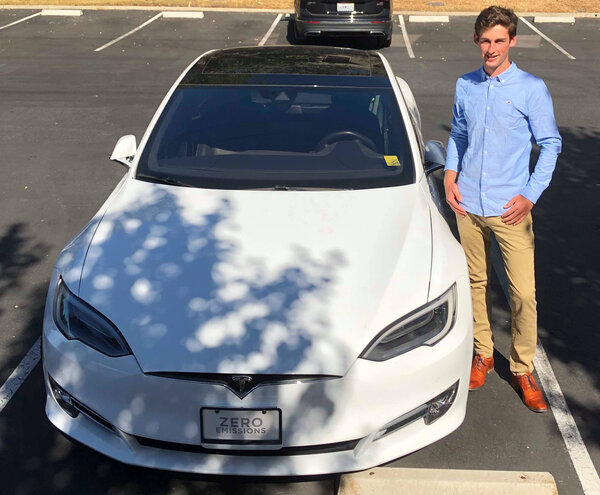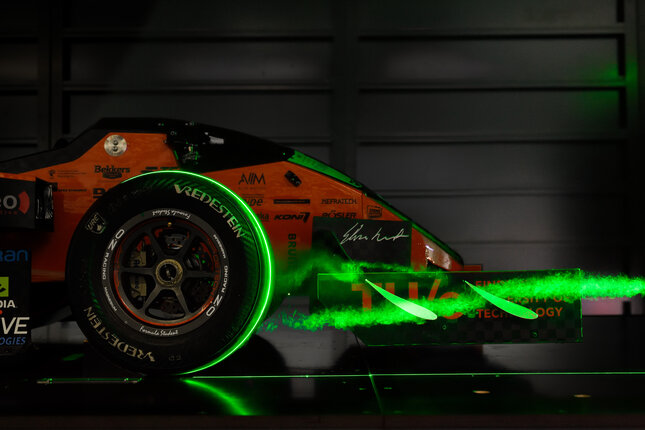‘My time at URE got me noticed by Tesla recruiters’
Dennis de Niel's experience at University Racing Eindhoven has brought him a lot.

Dennis de Niel's time at University Racing Eindhoven laid a solid foundation for his career in the automotive sector. It got him noticed by his current employer Tesla, where he is living his childhood dream.
-
Who
Dennis de Niel (25), MSc in Mechanical Engineering (2020).
Read more -
Team
During his studies he held various positions at University Racing Eindhoven, such as aerodynamics engineer and team manager.
Read more -
And now...
Dennis is vehicle dynamics control engineer at Tesla in California.
Read more
Cool, a job at Tesla!
“For sure! I'm living my childhood dream, doing this job. As a vehicle dynamics control engineer, I work mainly on vehicle stability software, such as traction control. It's great to work in a multidisciplinary team of people with the same vision and motivation. It reminds me very much of my times at URE, where everyone shared the same passion.”
Did your work at URE grab Tesla's attention?
“It definitely got me noticed more by Tesla recruiters. URE strengthened my CV considerably because of the additional knowledge and practical experiences. Also, Tesla sees a huge added value in students who have gained extra practical know-how alongside their studies. For example, they go to Formula Student events and actively look for students for internships or jobs.”

Tell us a little more about URE?
“Every year, URE competes in the Formula Student competition, the world's biggest design competition for students. Each year the team has to design, produce and test an all-new electric race car to race during the summer. We compete against around 800 teams from all over the world.
The Formula Student competition is organized with the primary goal of preparing students for the job market in both technical and non-technical areas.”
How much time did you spend working in URE?
“I held different positions over multiple years. During my first two years as a part-time member, I spent about ten hours a week on URE. During my full-time year, I spent all day, every day during the week, and some weekends at URE. After my full-time year as an advisory member, I was involved with URE for ten to 15 hours a week at times. You can also spend less time per week or only certain weeks on URE. However, there's definitely room to take on greater responsibilities and new tasks.”
What did you learn from your time at URE?
“It was one of the most instructive times of my career. I gained a lot of new technical knowledge but also learned how to convert that knowledge into practice. There are a lot of steps between a design and actually converting that design into a product. For that, we had to work closely with, say, different companies, but we also had to make sure the money was there to realize the design.
One of the things I learned very well was how to work in a multidisciplinary team. Everyone has different backgrounds and different ways of working and communicating.”
Did your time on the team help you in your future career?
“Definitely! Some automotive companies consider a year of Formula Student as a year's work experience. I also certainly got to see that there's a big difference between the TU/e's technical assignments and URE's design assignments. At URE, the designs actually have to be produced and then tested on the car. You have to consider all the production requirements but also already think about how they should be validated and tested. That's exactly how it's done within companies. And the great thing is, you go through all these phases in a single year.”

What was a highlight during the time you were on the team?
“When we finished fifth at the competition in Germany, the Formula Student Germany. That competition is considered the unofficial world championship. When you, as a team, after a year of full-time, very hard work, manage to get the best result up to that point - that was a fantastic feeling!”
Were the disappointments too?
“Several, in fact. For instance, on the morning of the competition in the Netherlands, one of the car's parts broke. That has a major impact on the car's speed. At that point, we came together as a team. And we fixed the car in the parking lot there and then. It showed us that teamwork makes the dream work.”
What advice would you give students considering joining a student team?
“Go and speak to a student team that interests you. They're much easier to join than you think and you can always say you want to start with a smaller assignment and see how you like it. Besides, gaining a lot of new technical knowledge, you'll make life-long friendships!”
More on our strategy


![[Translate to English:] [Translate to English:]](https://assets.w3.tue.nl/w/fileadmin/_processed_/c/f/csm_BvOF_2024_0319_AEV_license_TUe_Dirk_van_Meer_-_CORE_1__c976e259a5.jpg)
